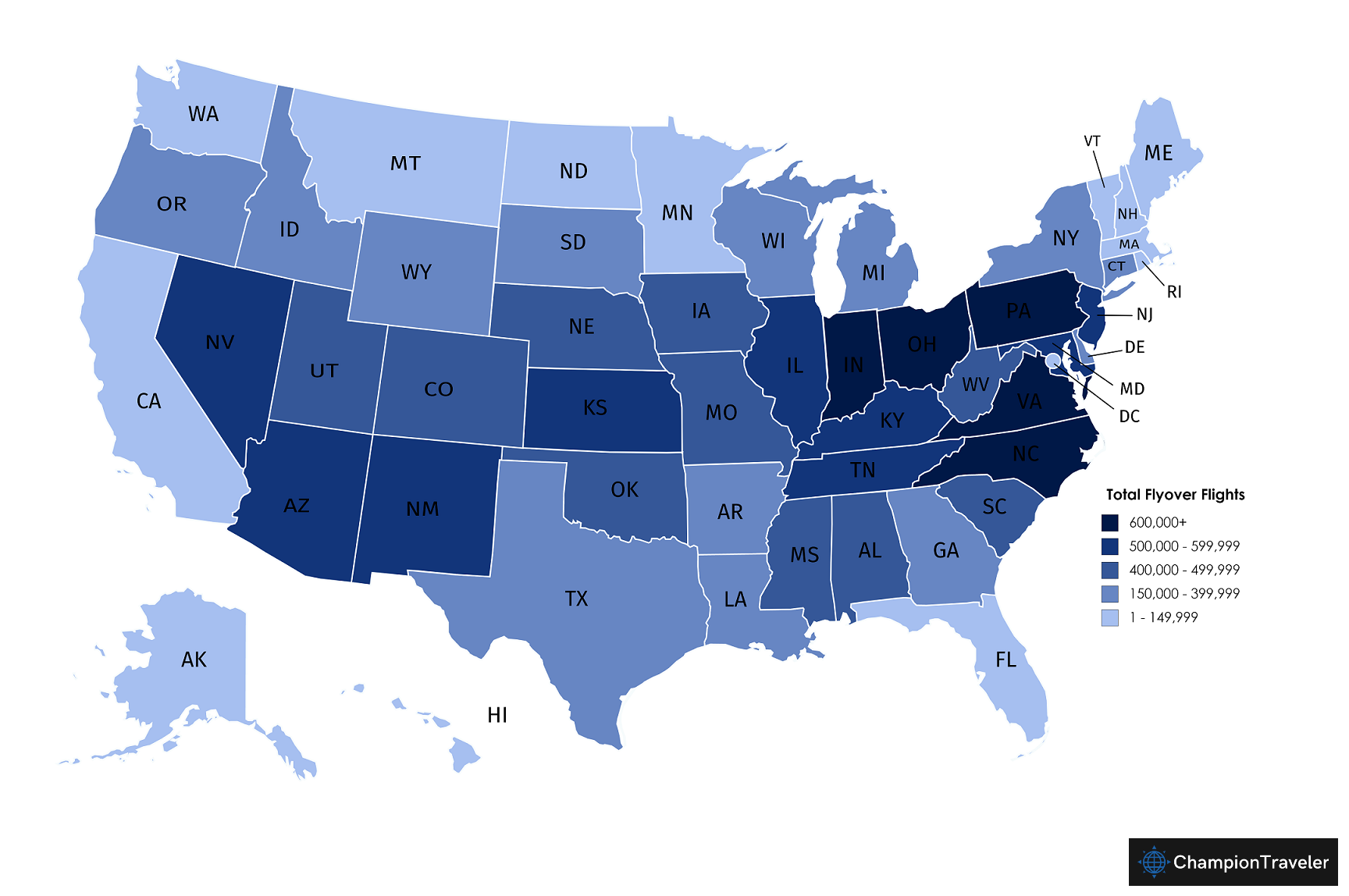“Flyover states” is an often-pejorative term for states that are perceived as boring. These are states that are passed over rather than visited. Our new analysis shows that West Virginia is the ultimate flyover state with almost 200 times more flights going overhead than flying to the state. Poor West Virginia — always flown over, never a destination. While Randall Monroe of XKCD is correct that Virginia is actually the most flown-over state (source), it’s also fairly popular as a destination. In our analysis of all 5.6 million domestic flights in the last 12 months we ran analysis on flight path for every flight and mapped which states each flight passes over. We then looked not only at the raw number of flyovers, but also at the ratio between destination flights and flyovers.
Ratio of flyover flights to destination flights (12 months):
Total flyover flights:
Total destination flights:
Table of 12 months’ flight data, ordered by flights over divided by flight to the state
| State | Flights to | Flights over | Flyover vs. Destination |
|---|---|---|---|
| 1. West Virginia | 2,387 | 466,364 | 195.4 |
| 2. Kansas | 9,703 | 507,638 | 52.3 |
| 3. Mississippi | 10,068 | 423,605 | 42.1 |
| 4. Iowa | 12,817 | 499,965 | 39.0 |
| 5. Kentucky | 16,178 | 576,293 | 35.6 |
| 6. Wyoming | 7,917 | 244,716 | 30.9 |
| 7. Virginia | 32,205 | 921,977 | 28.6 |
| 8. New Mexico | 21,399 | 575,862 | 26.9 |
| 9. Arkansas | 14,974 | 394,876 | 26.4 |
| 10. Alabama | 23,843 | 447,931 | 18.8 |
| 11. South Dakota | 8,052 | 151,268 | 18.8 |
| 12. Nebraska | 22,970 | 414,412 | 18.0 |
| 13. Indiana | 39,282 | 661,138 | 16.8 |
| 14. Oklahoma | 30,020 | 433,732 | 14.4 |
| 15. South Carolina | 30,263 | 435,378 | 14.4 |
| 16. Rhode Island | 13,151 | 139,544 | 10.6 |
| 17. Connecticut | 21,501 | 194,478 | 9.0 |
| 18. Idaho | 21,500 | 193,891 | 9.0 |
| 19. Ohio | 85,730 | 611,896 | 7.1 |
| 20. Tennessee | 81,729 | 564,572 | 6.9 |
| 21. Pennsylvania | 110,556 | 658,666 | 6.0 |
| 22. Maryland | 99,031 | 581,602 | 5.9 |
| 23. North Dakota | 10,726 | 61,088 | 5.7 |
| 24. Montana | 17,004 | 91,710 | 5.4 |
| 25. New Jersey | 122,974 | 587,842 | 4.8 |
| 26. Missouri | 104,404 | 487,271 | 4.7 |
| 27. Louisiana | 67,165 | 284,215 | 4.2 |
| 28. Vermont | 3,708 | 15,681 | 4.2 |
| 29. North Carolina | 162,329 | 676,605 | 4.2 |
| 30. Utah | 114,239 | 418,604 | 3.7 |
| 31. Nevada | 167,198 | 546,578 | 3.3 |
| 32. Arizona | 176,531 | 567,688 | 3.2 |
| 33. Wisconsin | 51,257 | 158,719 | 3.1 |
| 34. New Hampshire | 6,364 | 19,672 | 3.1 |
| 35. Oregon | 71,099 | 174,412 | 2.5 |
| 36. Colorado | 245,548 | 461,304 | 1.9 |
| 37. Michigan | 155,896 | 241,652 | 1.6 |
| 38. Illinois | 352,071 | 537,712 | 1.5 |
| 39. New York | 246,409 | 327,887 | 1.3 |
| 40. District of Columbia | 111,168 | 84,969 | 0.8 |
| 41. Georgia | 391,889 | 254,667 | 0.6 |
| 42. Minnesota | 138,461 | 60,761 | 0.4 |
| 43. Texas | 565,292 | 175,684 | 0.3 |
| 44. Washington | 148,410 | 26,831 | 0.2 |
| 45. Massachusetts | 125,110 | 20,946 | 0.2 |
| 46. California | 740,782 | 14,562 | 0.0 |
| 47. Florida | 452,180 | 3,177 | 0.0 |
| 48. Alaska | 35,897 | – | – |
| 48. Hawaii | 102,602 | – | – |
| 48. Maine | 7,299 | – | – |
| 48. Puerto Rico | 29,152 | – | – |
| 48. Virgin Islands | 6,092 | – | – |
| 48. Guam | 485 | – | – |
| N/A. Delaware | – | 383,906 | N/A |
West Virginia blows every state out of the water in its flyover ratio. There are two factors here: unavoidable geography and popularity. West Virginia’s unavoidable geography between major hub cities means it will be flown over more, whereas a state like Alaska is never flown over by domestic travelers. However, in raw terms, 16 other states are flown over more often than West Virginia, but each one of them has a lower flyover ratio than West Virginia due to the number of destination flights. There’s just not much to do in and around West Virginia’s airports. Aside from Delaware (the only state with no airport) and Guam (which is tiny), West Virginia is the least-popular destination.
Kansas, Iowa, and Kentucky all land in the top 5, which is the least-surprising result of this analysis given that “flyover country” generally refers to the Midwest. Surprisingly, Missouri bucks this trend at the middle of the list despite being beneath some major cross-continental air traffic.
Mississippi stands out as the southern state that gets flown over but is rarely a destination. There’s a saying for that in the South: thank God for Mississippi. (Because Mississippi occupies the bottom of many lists, saving other states from the shame of being ranked last.)
Data Sources:
—



LOL I have no idea when this article was created but just found this. Since not every flight/aircraft is the same or holds the same # of passengers, can you gather data for # of travelers and compare to # of flyover flights?